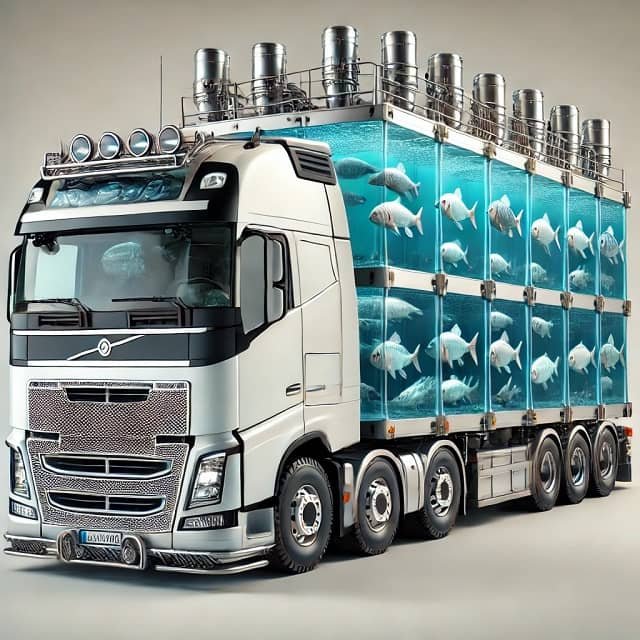While aquaculture offers a sustainable solution to overfishing, the success of aquaculture operations relies heavily on maintaining optimal conditions within marine cages where fish are cultivated. The primary factors affecting the availability of oxygen within these cages can be divided into slow-changing parameters (temperature, salinity, and atmospheric pressure) and fast-changing parameters (current velocity and fish oxygen consumption), encompassing variations occurring from seasonal to hourly changes.
A team of researchers from the University of Copenhagen, Hiddenfjord, and the Copenhagen Academy for Medical Education and Simulation suggests that optimizing feeding strategies can be achieved by modeling and understanding oxygen availability within marine cages. They propose using the model’s results to plan feeding schedules, emphasizing that when oxygen concentrations fall below a certain threshold, food is not utilized optimally, reducing its energy value for the fish.
In this context, the researchers created a conceptual model to comprehend how fish and the environment affect oxygen availability within marine cages, with the aim of reducing excess, unutilized food and minimizing environmental impact, optimizing feed conversion rates, and ultimately improving fish health within the cage.
The Study
The study focused on understanding the swimming energy dynamics in rainbow trout (Oncorhynchus mykiss) under different oxygen conditions and temperatures. Specifically, the researchers investigated the effects of normoxia and hypoxia at temperatures of 10°C, 15°C, and 20°C. These experiments provided valuable insights into how fish behavior and energy expenditure change in response to various environmental factors.
Development of a Predictive Model
Models are invaluable tools that enable researchers to explain aspects of nature that are otherwise challenging to understand. Currently, models exist for the growth and behavior of Atlantic salmon in marine cages. In this regard, using data obtained from swimming energy experiments, the researchers developed a conceptual model that predicts oxygen conditions within marine cages.
This model takes into account the main drivers of oxygen levels, which include fish oxygen consumption and water exchange driven by water flow through the cage.
Case Study: Temperature Increase
The researchers applied their model to a case study to examine the effects of a temperature increase within a marine cage. The results of this study were particularly enlightening. They found that a simple 10°C temperature increase caused a significant drop in oxygen concentration, approximately three times faster than in cooler conditions.
To maintain an optimal oxygen concentration within the cage, it was necessary to increase the flow velocity by a factor of 3.7. This implies that aquaculture farms, facing rising sea temperatures due to climate change, must adapt their water circulation systems to avoid suboptimal oxygen conditions within the cages.
Stay Always Informed
Join our communities to instantly receive the most important news, reports, and analysis from the aquaculture industry.
The findings underscore the urgent need for innovative strategies to maintain fish health and productivity in the face of changing environmental conditions.
Relevance for Aquaculture
The implications of this study are of utmost importance for the aquaculture industry. With the predictive model, aquaculturists can gain a better understanding of when and why suboptimal conditions might occur within marine cages.
By proactively adjusting their operations to maintain suitable oxygen levels, they can ensure optimal feed intake, fish growth, and overall health. This approach not only safeguards the well-being of the fish but also contributes to the sustainability and profitability of aquaculture ventures.
Future Applications
Beyond its immediate applications, the developed model can be employed to estimate the suitability of potential new aquaculture sites. This allows for more informed decision-making in site selection and reduces the risks associated with establishing aquaculture operations in areas where maintaining optimal oxygen conditions may be challenging.
In conclusion, the study on trout swimming energetics and the subsequent development of a predictive model for oxygen conditions in marine cages represent a significant step forward in aquaculture research and practice.
By harnessing this knowledge, aquaculturists can enhance the efficiency and sustainability of their operations, ultimately contributing to the responsible production of seafood to meet the world’s growing demand.
The model developed by the scientists can be reviewed here.
The research has been funded by the Green Growth and Development Program (GUDP) under the Danish Ministry of Food, Agriculture, and Fisheries through the “GUDP FITFISH” project.
Contact
Professor John Fleng Steffensen
Marine Biological Section
Strandpromenaden 5
DK-3000 Helsingør
Mail: jfsteffensen@bio.ku.dk
Telefon: +45 35 32 19 86
Mobil: +45 60 77 04 90
Reference (open access)
Bergsson, H.; Svendsen, M.B.S.; Steffensen, J.F. Model of Oxygen Conditions within Aquaculture Sea Cages. Biology 2023, 12, 1408. https://doi.org/10.3390/biology12111408
Editor at the digital magazine AquaHoy. He holds a degree in Aquaculture Biology from the National University of Santa (UNS) and a Master’s degree in Science and Innovation Management from the Polytechnic University of Valencia, with postgraduate diplomas in Business Innovation and Innovation Management. He possesses extensive experience in the aquaculture and fisheries sector, having led the Fisheries Innovation Unit of the National Program for Innovation in Fisheries and Aquaculture (PNIPA). He has served as a senior consultant in technology watch, an innovation project formulator and advisor, and a lecturer at UNS. He is a member of the Peruvian College of Biologists and was recognized by the World Aquaculture Society (WAS) in 2016 for his contribution to aquaculture.




